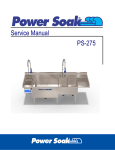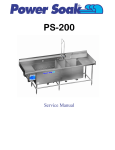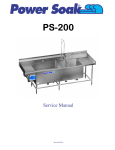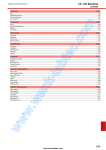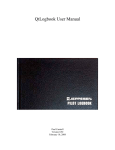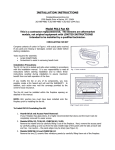Download Power Soak PS-200 & PS-201 Service Manual
Transcript
SERVICE MANUAL PS-200 & PS-201 Table of Contents Explanation of Warning Messages......................................................................................... 1 Danger............................................................................................................................................ 1 Warning......................................................................................................................................... 1 Personal Injury Hazard........................................................................................................... 1 Chemical Hazard........................................................................................................................ 1 Preventive Maintenance ............................................................................................................ 2 Daily ................................................................................................................................................ 2 Monthly ......................................................................................................................................... 2 Troubleshooting ............................................................................................................................ 3 Hazard to Untrained or Unauthorized Personnel. ...................................................... 3 Pump leaks ................................................................................................................................... 3 Intermittent running ............................................................................................................... 3 Pump does not work ................................................................................................................ 4 Pump works- Heater does not work ................................................................................. 4 Water too hot or not hot enough ........................................................................................ 4 No Power ...................................................................................................................................... 5 Error Codes .................................................................................................................................. 5 Component Operation and Checks ........................................................................................ 7 Liquid Level Sensors ................................................................................................................ 7 Thermistor ................................................................................................................................... 7 Heater Thermodisc (Hi-Limit or Cutoff Switch) .......................................................... 8 Transformer ................................................................................................................................ 8 Triac (Thyristor or Solid-State Relay).............................................................................. 9 Contactor ...................................................................................................................................... 9 Heater Element .......................................................................................................................... 9 Parts List ........................................................................................................................................ 10 Motor – Impeller – Pump Assembly ............................................................................... 10 Motor – Impeller- Pump Assembly................................................................................. 11 Motor – Impeller- Pump Assembly................................................................................. 11 Heater.......................................................................................................................................... 13 Control Panel ........................................................................................................................... 14 Miscellaneous .......................................................................................................................... 14 Optional Chemical Dispenser ............................................................................................ 15 Electrical Schematic .................................................................................................................. 16 208-240 volt 60 Hz 1 phase ............................................................................................... 16 208-230 volt 60 Hz 3 phase ............................................................................................... 17 460 volt 60 Hz 3 phase ........................................................................................................ 18 Electrical Schematic (European) ......................................................................................... 19 400 volt 50 Hz 3 phase ........................................................................................................ 19 230 volt 50 Hz 3 phase ........................................................................................................ 20 Motor and Pump Assembly.................................................................................................... 21 Exploded View ......................................................................................................................... 21 Motor and Pump Assembly & Disassembly Procedures ........................................... 22 DISASSEMBLY PROCEDURE: ............................................................................................ 22 INSPECTION OF THE COMPONENTS: ........................................................................... 22 ASSEMBLY PROCEDURE:.................................................................................................... 22 Appendix A.................................................................................................................................... 24 Explanation of Warning Messages Read, understand and follow all DANGER, WARNING, and CAUTION messages located in this guide and on the equipment. Danger Personal Injury and Property Damage hazard. May result in serious injury of death. May cause extensive equipment damage. Warning Property Damage Hazard. May result in property or equipment damage. Personal Injury Hazard Hazard from sharp objects. May result in serious injury or death. Chemical Hazard May result in serious injury or death. Instructions, labels and Material Safety Data Sheets (MSDSs) should be supplied with all detergents and sanitizing chemicals. The manufacturers, importers and distributors of your cleaning chemicals are responsible for providing this information. 1 Preventive Maintenance Power Soak machines require minimal, routine preventive maintenance. As such, the following should be done on a routine basis to ensure that your system remains reliable: Daily Clean the liquid level sensors. These sensors are located on the side walls of the wash and sanitizer tanks. They are the white plastic discs with metal centers. Clean the sensor faces thoroughly. If cleaned regularly, a washcloth and soapy water are all that is required. If the liquid level sensors are not cleaned regularly, the machine may fail to operate. Dirty sensors may create a situation that will allow the machine to run without water, which can cause serious damage to the unit. Monthly IMPORTANT: Turn off the power to the unit at the main breaker prior to performing the following task! After shutting off the power at the system’s dedicated breaker, clean the pump motor fan shroud with a stiff bristle brush and a vacuum. If a brush and vacuum are unavailable, clean the shroud with a damp, soapy rag. The motor shroud is the “vented” cover located at the end of the motor (closest to the control panel). This will prevent grease and dust from accumulating in the cover’s openings, which can obstruct the airflow that cools the motor. De-lime the wash sink. Simply add a de-liming agent to a sink of warm, fresh water and run the system overnight. Ask your chemical sales representative to recommend a specific de-liming agent. Note: The motor bearings do not need to be greased because they are permanently sealed. If you have any questions regarding the preventive maintenance procedures, please contact the factory at 800-444-9624. 2 Troubleshooting Hazard to Untrained or Unauthorized Personnel. The following procedures are provided for use by an authorized service agency. No facility owner, manager, employee or other unauthorized person should attempt to perform any of these procedures. To obtain the name of a recommended service agent in your area, please call the Power Soak Service Department. 800-444-9624. When performing trouble shooting procedures, the authorized service agency will need to open the electrical enclosure on the Power Soak machine. The control panel must be properly closed before reconnecting the power to the machine. Pump leaks Look for 1 Defective ADAPTER O-RING 2 Defective PUMP SEAL Correction Replace Replace Intermittent running See “Pump does not work” below 3 Pump does not work Look for 1 Slow flashing Green Light 2 Solid Blue Light 3 Error LED on UPM 4 Red, Green, Blue lights blinking together 5 No indicator lights at all Correction Clean Liquid Level Sensors. Fill sink with water to proper level. Tighten the External Wiring Harness on back of Control Panel. Clean Liquid Level Sensors. Drain sink and refill with proper water level. Record the pattern – See “Error Codes” Low power to UPM – See “No Power” Water too hot – reduce temperatures to 115° with ice or cold water See “No Power” Pump works- Heater does not work Look for 1 Water temperature < 110°F 2 Water temperature between 110°F and 120°F 3 Water temperature > 120°F Correction Check Heater and replace as necessary. Check Triac(s) and replace as necessary. Normal operating temperature. Check Thermistor and replace as necessary. Too much soap can cause excessive heat buildup Water too hot or not hot enough Look for 1 Water temperature < 110°F 2 Water temperature between 110°F and 120°F 3 Water temperature > 120°F Correction Check Heater and replace as necessary. Check Triac(s) and replace as necessary. Normal operating temperature. Check thermistor and replace as necessary. Too much soap can cause excessive heat buildup. 4 No Power Look for 1 Incoming voltage between L1 and L2 (L1L2) (Also L1-L3, L2-L3 if 3 phase) 2 Less than 10 volts to UPM (leave UPM plugged in during check) Correction Check Heater and replace as necessary. Water too hot, above 135°F – empty sink and refill with 115°F water. Tighten the External Wiring Harness on back of Control Panel. Check transformer and replace as necessary. Check thermal cutoff for heater and replace as necessary. Check thermal cutoff for motor and replace as necessary. Error Codes ~ Represents a “long” flash * Represents a “short” flash Look for 1 ~~~* Liquid Level Error Correction This error appears when the upper liquid level sensor sends a signal to the UPM (W-H light is illuminated) and the low liquid level sensor is not sending a signal to the UPM (W-L is not illuminated). The low level sensor may not be functioning due to a coating of debris or a broken/disconnected wire that is preventing the signal to the UPM. A continuous signal from the upper level sensor can be caused by debris coating the face of the sensor or faulty wiring that has the sensor connection grounded to the wash tank when there is no fluid in the tank. The liquid level lights on the UPM can be used to help determine the problem. 5 2 ~~~** Temperature Sensor Error When the UPM receives a signal from the thermistor that is outside the range of the UPM programming, the temperature sensor error will actuate. The UPM will signal an error if it reads a resistance greater than 430 k and less than 15 k. Check and replace Thermistor as necessary. 3 ~~~*** Over Current Error If any of the high voltage components begin drawing excessive current, the current sensor will send a signal to the UPM to start the Over Current Error and deactivate the contactor which turns the power off to the machine. Check and replace the transformer, motor and/or heater as necessary. 4~~~**** Over Temperature Error If the fluid temperature in the wash tank exceeds 135°F it will activate this error message and stop the machine. This error code cannot be reset until the fluid is drained below the low level sensor in the wash tank. Current Sensor Error The UPM must receive a signal from the current sensor to verify that it is connected and working. If it does not receive the signal, the UPM program will stop the machine and give this error code. 5~~~***** 6~~~****** Membrane Error In the event that one of the control panel buttons sends a constant signal to the UPM, the program will recognize that the membrane is defective and display this error code (see Section 6.9 Push Button Membrane). 6 Component Operation and Checks The following checks should only be performed by qualified technicians using extreme caution. Electrical hazard to untrained personnel may result in electrical shock, burns, or death. Liquid Level Sensors There are two Liquid Level Sensors (LLS) in the wash sink, and two more in the sanitize sink (if equipped with a sanitize sink). To check operation, first unplug the white connector from the UPM. Using and Ohm meter, measure the resistance between the face of the LLS and the appropriate pin of the white connector. The meter should read less than one ohm. Refer to the chart below for the appropriate pins. Description Wash Sink Low LLS Wash Sink High LLS Sanitize Sink Low LLS Sanitize Sink High LLS UPM pin number Pin 19 Pin 20 Pin 21 Pin 22 Wire Color White with Orange stripe White with Green stripe White with Yellow stripe White with Blue stripe If the meter shows a reading higher than one Ohm, there may be a dirty sensor, a broken wire, or a loose connection. The loose connection may be at the sensor, the wiring harness, or the external wiring harness may not be tight at the back of the Control Panel. Thermistor The Thermistor is a temperature sensor. The UPM measures the resistance through the Thermistor, and associates that resistance to a temperature. To check operation, first unplug the white connector from the UPM. Next, measure the resistance across the Thermistor. This reading can be attained at the white UPM connector (reference “UPM” for pin layout), between pin 8 and pin 9. If the reading varies significantly from the Temperature-Resistance chart in Appendix A, the Thermistor may be defective. The UPM will signal an error if it reads a resistance greater than 430 kΩ and less than 15kΩ. The Thermistor is located close to the Heater, inside the Sensor Pad. When replacing a Thermistor, it is helpful to use a glue dot to hold it in place while reattaching the Sensor Pad to the sink. Also, it is imperative to put heat sink compound on the side of the Thermistor that will be against the sink, and the Heater Thermodisc as well, to help ensure good heat transfer. 7 Heater Thermodisc (Hi-Limit or Cutoff Switch) The Heater Thermodisc is a protection device. If the temperature at the Thermodisc reaches 135°F, the disc opens, cutting off power to the UPM. To check operation, first shut off the circuit breaker to the sink. Next, unplug the connectors P9 and J10 form J9 and P10 for the Motor Thermodisc (reference schematic or “Motor Thermodisc” for location and description). Device should read less than one ohm when closed. If the reading is more than one ohm, the Thermodisc may be defective. Next, check for a short to ground. If there is a short to ground from either side of the Thermodisc, the Thermodisc is either defective, or there may be water in the sensor pad. This condition will keep the UPM from operating correctly. The Thermodisc is located close to the Heater, inside the Sensor Pad. When replacing a Thermodisc it is helpful to use a glue dot to hold it in place while reattaching the Sensor Pad to the sink. Also it is imperative to put hear sink compound on the side of the Thermodisc that will be against the sink, and the Thermistor as well, to help ensure good heat transfer. Motor Thermodisc (Hi-Limit or Cutoff Switch) The Motor Thermodisc is a protection device only the motor. If the temperature of the motor reaches 180°F, the disc opens, cutting off power to the UPM, and the UPM turns off the power to the motor. To check operation, first shut off the circuit breaker to the sink. Next, unplug the connectors P9 and J10 from J9 and P10 for the Motor Thermodisc (reference schematic for location and description). These connectors plug the two Thermodisc wires (black) to two yellow wires coming out of the internal wiring harness of the Control Panel. Measure the resistance between J9 and P10 (reference schematic, these are the black Thermodisc wires). The device should read less than one ohm when closed. If the reading is more than one ohm, the Thermodisc may be defective. Next, check for a short to ground. If there is a short to ground from either side of the Thermodisc, the Thermodisc is either defective or there may be water on the Thermodisc. This condition will keep the UPM from operating correctly. On some of the Power Soak motors, the Thermodisc is built in to the motor, which is not replaceable. On others, it is located in the wiring box of the Motor, which is replaceable. When replacing, it is imperative to put heat sink compound on the side of the Thermodisc that will be against the motor to help ensure good heat transfer. Transformer The Transformer reduces the incoming power supply voltage to 24 volts, with a 12-volt center-tap. The transformer has acceptable inputs of 120, 240, and 277 volts. It should already be wired to the specifications of the Control Panel (refer to schematic). To test the Transformer, first verify the input voltage. This can be done between the L2 terminal and the down-stream/transformer side of the fuse. The fuse holder can be found on the end of the terminal strip. Next, verify the output voltage of the Transformer. The reading should be 24 volts across the outputs, and 12 volts between the center-tap and each of the other outputs. These voltages can be verified at the three wire nuts on the internal wiring harness near the Transformer. Note the wire colors on the schematic for each wire nut. 8 Triac (Thyristor or Solid-State Relay) The Triac is a three terminal semiconductor for controlling current in either direction. The Triac in the Power Soak is used similar to a contactor. When a gate voltage is applied from the UPM (similar to coil voltage on a mechanical Contactor Relay), the Triac conducts (closes) through the power terminals. On a single phase Control Panel, there are two Triacs, one for the Heater, the other for the Motor. Terminals 2 and 3 on each Triac are supplied with incoming voltage. On the top of these Triacs, they are labeled M1 (motor leg 1) and H1 (heater leg 1). On a three phase Control Panel there are four Triacs, two for the Heater, and two for the Motor. Two are labeled identically to a single phase Panel. The two others are labeled M3 (motor leg 3) and H3 (heater leg 3). Terminals 2 and 3 on each Triac are supplied with incoming voltage. To test the Triac, first verify the input voltage to the Triac. An LED on the Triac board signals whether the gate voltage has been applied by the UPM. If the light is on, the Triac should be closed, and terminal 1 of the Triac should be supplying power to the respective device. If the LED is off, there should be virtually no current on the output side of the Triac. Contactor If there is a 20v-28v across the coil and the contactor does not pull in, the contactor is defective. If there is input voltage across terminals L1 and L2 (also L1-L3 and L2-L3, if three phase) and the contactor is pulled in, but no voltage across terminals T1 and T2 (also T1-T3 and T2-T3, if three phase), the contactor is defective. Heater Element The heater in a Power Soak sink is rated at 7000 watts. To check operations of the heat element, first turn the power off at the breaker. Disconnect the H2 wire from terminal H2 and the H1 wire from the triac H1 (and H3 wire from H3 triac, if 3 phase) from the Control Panel. Check each heater lead to ground for short. They all should be open to ground. Check resistance between each of the combinations of the chart below. Heater Rated phase Resistance (ohms) Connection Voltage H1-H2 208-230 1 7.56 H1-H2 208-230 3 15.12 H2-H3 208-230 3 15.12 H1-H3 208-230 3 15.12 H1-H2 460 1 32.91 H1-H2 460 3 65.83 H2-H3 460 3 65.83 H1-H3 460 3 65.83 The heater should be within a 10% variance of the value of the chart. If the reading varies significantly from the chart above, the heater may be defective, or there may be a broken wire or loose connection. Electrically, the Heater is three separate elements, each of 2333 watts. When replacing, note how the existing Heater is wired, and refer to the schematic when wiring new heater. 9 Parts List Motor – Impeller – Pump Assembly 60 Hz – Self-Draining HP Side Phase Volt Motor Impeller 1.5 1.5 1.5 1.5 1.5 1.5 1.5 1.5 2.0 2.0 2.0 2.0 2.0 2.0 2.0 2.0 3.0 3.0 5.0 5.0 5.0 5.0 LH RH LH RH LH RH LH RH LH RH LH RH LH RH LH RH LH/RH LH/RH LH RH LH RH 1 1 1 1 3 3 3 3 1 1 1 1 3 3 3 3 3 3 3 3 3 3 208 208 230 230 208 208 230/460 230/460 208 208 230 230 208 208 230/460 230/460 208 230/460 208 208 230/460 230/460 29506 29506 29500 29500 29508 29508 29502 29502 29507 29507 29501 29501 29509 29509 29503 29503 29510 29504 29511 29511 29505 29505 27590 27591 27590 27591 27590 27591 27590 27591 27592 27593 27592 27593 27592 27593 27592 27593 27594 27594 27596 27597 27596 27597 10 Motor – Impeller- Pump Assembly 60 Hz – Not Self-Draining HP Side Phase Volt Motor Impeller 1.5 LH 1 208/230 27590 2.0 LH 1 208/230 2.0 LH 3 230/460 3.0 LH 3 230/460 see above see above see above see above 27592 27592 27594 Motor – Impeller- Pump Assembly 50 Hz – European HP 1.5 1.5 1.5 1.5 2.0 2.0 3.0 3.0 5.0 5.0 side LH RH LH RH LH/RH LH/RH LH RH LH RH Phase 1 1 3 3 1 3 3 3 3 3 Volt 220 220 380 380 220 380 380 380 380 380 Motor 29512 29512 29514 29514 29513 29515 29516 29516 29517 29517 Impeller 27592 27593 27592 27593 27594 27594 27488 27489 ? ? 11 Pump Parts Common to all Part # 28920 27886 27047 27132 *27480 *27475 *27476 27477 *27478 *27479 27481 27483 28262 Description Seal Kit Thermodisc-motor-thermal cutoff Intake gasket Discharge gasket Mechanical Seal “O” ring – sleeve “O” ring – seal plate Key Impeller Bolt Fiber Washer Sleeve Cap Screw – seal plate Dowel Pin * These items are contained in seal kit 28920 12 Heater Part # 27743 27744 27839 29243 27930 29244 27939 27934 27702 27934 27702 27934 18797 27926 28454 27322 28928 29077 Description Element – 230 volt – rev. A – ribbon – rear mount Element – 460 volt – rev. A – ribbon – rear mount Gasket for Chromolex heater Element – 208 volt –rev. B – wire – bottom mount – not available yet Element – 230 volt – rev. B – wire – bottom mount Element – 380 volt –rev. B – wire – bottom mount – not available yet Element – 480 volt – rev. B – wire – bottom mount Gasket for Accutherm heater Cover – rev. A – front mount – 17” Cover – rev. B – angle mount – 14” Cover – rev. C – after 02/05/04 – 12” Bolt – heater cover Terminal strip – heater Thermistor – temperature sensor Thermodisc – heater – thermal cutoff Sensor pad Heatsink compound Retainer Plate 13 Control Panel Parts # 27901 27902 27903 27171 27172 27920 27923 27924 27925 27928 28923 27927 27200 27922 Description Control Panel 220 volt single phase Control Panel 220 volt three phase Control Panel 480 volt three phase Contactor Transformer – 24 volt UPM – Programming Module Terminal Block Grounding Block Din Rail – mount for terminal blocks Triac – solid state relay Fuse Block Heatsink Overlay – start/stop membrane Wiring Harness – internal to control panel Miscellaneous Part # 23987 23988 27847 27848 28065 28066 28669 27854 27854 28553 27855 Description Liquid Level Sensor Gasket – Liquid Level Sensor Wiring Harness – Wash Wiring Harness – Sanitize Wiring Harness Extension – 3ft Wiring Harness Extension – 6ft Utensil Basket Chemical Injector Connector – chemical injector Cap – chemical injector Gasket – chemical injector 14 Optional Chemical Dispenser Dual Pump Chemical Dispenser Part # 28900 28370 29233 29230 29231 29232 29235 29234 28067 29236 29237 29238 29239 29240 29241 29242 28703 28704 103-014 27858 28557 28901 29145 28555 Description Chemical Dispenser – Dual Pump – Generic Chemical Dispenser – Dual Pump – Kay Chemical Timer – solidstate Button Guard – metal Switch – MOM – N/O – metal Rectifier – bridge Lock & Key Motor – 24 volt – 120 rpm Wiring Harness – soap dispenser Hook & Loop Screw - #8-32 x 1/2” flat phillips s/s Spring Cone Screw - #10-24 x 1 ¾” pan phillips s/s Pump – 2 cc power wash Tape – double sided foam Key Screw - #6-32 s/s Nut – hex #6-32 s/s Nut Sert - #10-24 tsn Gasket – soap dispenser – PS-200 Overlay – soap dispenser – Kay Chemical Overlay – soap dispenser – generic Terminal Fork 22-18 #8 Insulated Decal – Overlay – Metcraft service 15 Electrical Schematic 208-240 volt 60 Hz 1 phase 16 208-230 volt 60 Hz 3 phase 17 460 volt 60 Hz 3 phase 18 Electrical Schematic (European) 400 volt 50 Hz 3 phase 19 230 volt 50 Hz 3 phase 20 Motor and Pump Assembly Exploded View 21 Motor and Pump Assembly & Disassembly Procedures DISASSEMBLY PROCEDURE: 1 Remove (3) nuts from the back of the adaptor plate. Slide the pump end out from the volute. 2 Holding the impeller to keep it from turning, loosen the washer head cap screw, and remove the screw and gasket. 3 Slide the impeller off of the shaft and remove the key. 4 Remove the seal/sleeve as a unit by pulling it off of the shaft. Some corrosion may prohibit movement and a lubricant may be used to penetrate between the sleeve and motor shaft. With the impeller and key removed, the shaft sleeve and the mechanical seal assembly can be removed. 5 Remove O-ring from the shaft sleeve. 6 With the shaft sleeve removed, the seal rotating assembly can be pulled off of the shaft sleeve. 7 Mark the adaptor plate and motor to insure proper re-assembly. Remove (4) screws from the adaptor plate. Take the adaptor plate off the motor. 8 Remove O-ring from adaptor plate. 9 With the adaptor plate removed, the seal seat can be removed using a screwdriver or by using your fingers. INSPECTION OF THE COMPONENTS: With pump end disassembled, clean all parts and check for worn and damaged areas. Worn or damaged metal parts should be replaced. The mechanical seal, gasket, O-ring, O-ring and washer head cap screw are replacement parts that are provided in the kit. All old parts must be discarded and are not to be reused. ASSEMBLY PROCEDURE: 1 Push the mechanical seal seat squarely into the seal bore of the adaptor plate by using fingers. A little lube can be used on the seal bore of the adaptor plate. Make sure the ceramic side is up and it is fully seated. 2 Install the adaptor plate and tighten (4) screws, which hold it to the motor face. Make sure the marks made in step 7 above line up. 3 Install O-ring into the groove of the adaptor plate. 22 4 Coat the shaft sleeve lightly with lube. Install the mechanical seal on the shaft sleeve using your hand to push against the seal face. Make sure rubber seal bellows are seated against sleeve shoulder and carbon seal face is not scratched or chipped. 5 Slide the shaft sleeve onto the motor shaft and install the O-ring on the groove of the sleeve. Using lube or grease on the O-ring will help hold the ring in place temporarily until the impeller is secured. 6 Install the key on the motor shaft and place the impeller on the motor shaft engaging the key. 7 Put the gasket on the washer head cap screw. 8 Install the impeller cap screw by holding the impeller, push the impeller back against the sleeve and the other hand tighten the screw to 23-ft lbs. of torque. (Do not over tighten as this could cause the gasket to squeeze out, become deformed and not seal properly. 9 Slide the pump end on the (3) studs of the volute. The motor junction box should be at the bottom. 10 Install (3) nuts on the stud and tighten to 23-ft.lbs. 23 Appendix A 24 Power Soak is a registered trademark of Cantrell Industries, Inc. The Power Soak Design and concept is fully patented. Power Soak Systems. Inc. 903 East 104th Street, Suite 130 Kansas City, MO 64131 Phone (816) 222-2400 Fax (816) 222-2419 (800) 444-9624 www.powersoak.com Part#: 34773 Rev: - A Rev Date: 12/19/13 25




























